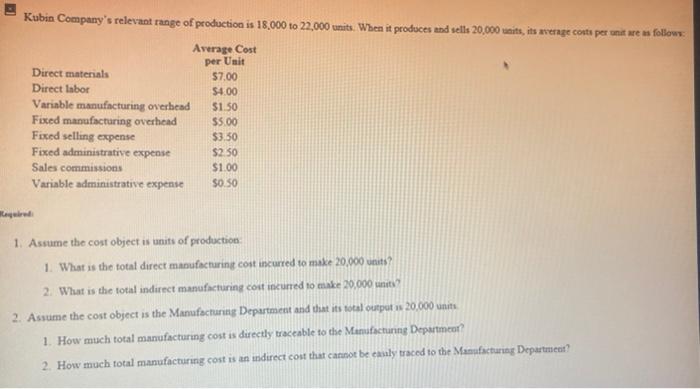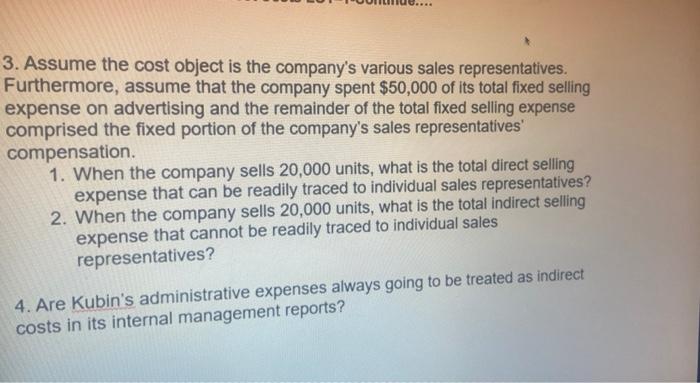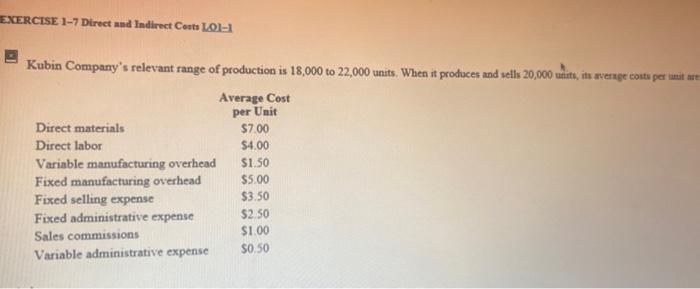what's thw solution in details? how did we find the numbers...
Kubin Company's relevant range of production is 18,000 to 22,000 units. When it produces and sells 20,000 uaits, its average cotts per anit are as followv: 1. Assume the cost object is units of production: 1. What is the total direct manufacturing coit incurred to make 20,000 units? 2. What is the total indirect manufacturing coit incurted to make 20.000 units? 2. Assume the cost object is the Manufacturiti Department and that its total outpot is 20.000 units 1. How much total manufacturing cost is directly traceable to the Manufacturng Department? 2. How much total manufacturing cost is an indirect cost that carnot be cauly traced to the Manufacturiag Department? 3. Assume the cost object is the company's various sales representatives. Furthermore, assume that the company spent $50,000 of its total fixed selling expense on advertising and the remainder of the total fixed selling expense comprised the fixed portion of the company's sales representatives' compensation. 1. When the company sells 20,000 units, what is the total direct selling expense that can be readily traced to individual sales representatives? 2. When the company sells 20,000 units, what is the total indirect selling expense that cannot be readily traced to individual sales representatives? 4. Are Kubin's administrative expenses always going to be treated as indirect costs in its internal management reports? 1. For financial accounting purposes, what is the total amount of product costs incurred to make 20,000 units? 2. For financial accounting purposes, what is the total amount of period costs incurred to sell 20,000 units? 3. For financial accounting purposes, what is the total amount of product costs incurred to make 22,000 units? 4. For financial accounting purposes, what is the total amount of period costs incurred to sell 18,000 units? EXERCTSE 1-7 Direct and ladirect Costs LOI-1 Kubin Company's relevant range of production is 18,000 to 22,000 units. When it produces and sells 20,000 uitits, its wernge cotte per anit ar EXERCISE 1-9 Flued, Variable, and Milwed Costs LOI-4 Refer to the data given in Exercike 1-7. Answer all questions independently. Repairnati: 1. If 18,000 units are produced and sold, what is the variable cost per unit produced and sold? 2. If 22,000 units are produced and sold, what is the variable cost per unit produced and sold? 3. If 18,000 units are produced and sold, what is the total amount of variable cost related to the units produced and sold? 4. If 22,000 units are produced and sold, what is the total amount of variable cost related to the units produced and sold? 5. If 18,000 units are produced, what is the average fixed manufacturing cost per unit produced? 6. If 22,000 units are produced, what is the average fixed manufacturing cost per unit produced? 7. If 18,000 units are produced, what is the total amount of fixed manufacturing overhead incurred to support this level of production? 8. If 22,000 units are produced, what is the total amount of fixed manufacturing overhead incurred to support this level of production? Kubin Company's relevant range of production is 18,000 to 22,000 units. When it produces and sells 20,000 uaits, its average cotts per anit are as followv: 1. Assume the cost object is units of production: 1. What is the total direct manufacturing coit incurred to make 20,000 units? 2. What is the total indirect manufacturing coit incurted to make 20.000 units? 2. Assume the cost object is the Manufacturiti Department and that its total outpot is 20.000 units 1. How much total manufacturing cost is directly traceable to the Manufacturng Department? 2. How much total manufacturing cost is an indirect cost that carnot be cauly traced to the Manufacturiag Department? 3. Assume the cost object is the company's various sales representatives. Furthermore, assume that the company spent $50,000 of its total fixed selling expense on advertising and the remainder of the total fixed selling expense comprised the fixed portion of the company's sales representatives' compensation. 1. When the company sells 20,000 units, what is the total direct selling expense that can be readily traced to individual sales representatives? 2. When the company sells 20,000 units, what is the total indirect selling expense that cannot be readily traced to individual sales representatives? 4. Are Kubin's administrative expenses always going to be treated as indirect costs in its internal management reports? 1. For financial accounting purposes, what is the total amount of product costs incurred to make 20,000 units? 2. For financial accounting purposes, what is the total amount of period costs incurred to sell 20,000 units? 3. For financial accounting purposes, what is the total amount of product costs incurred to make 22,000 units? 4. For financial accounting purposes, what is the total amount of period costs incurred to sell 18,000 units? EXERCTSE 1-7 Direct and ladirect Costs LOI-1 Kubin Company's relevant range of production is 18,000 to 22,000 units. When it produces and sells 20,000 uitits, its wernge cotte per anit ar EXERCISE 1-9 Flued, Variable, and Milwed Costs LOI-4 Refer to the data given in Exercike 1-7. Answer all questions independently. Repairnati: 1. If 18,000 units are produced and sold, what is the variable cost per unit produced and sold? 2. If 22,000 units are produced and sold, what is the variable cost per unit produced and sold? 3. If 18,000 units are produced and sold, what is the total amount of variable cost related to the units produced and sold? 4. If 22,000 units are produced and sold, what is the total amount of variable cost related to the units produced and sold? 5. If 18,000 units are produced, what is the average fixed manufacturing cost per unit produced? 6. If 22,000 units are produced, what is the average fixed manufacturing cost per unit produced? 7. If 18,000 units are produced, what is the total amount of fixed manufacturing overhead incurred to support this level of production? 8. If 22,000 units are produced, what is the total amount of fixed manufacturing overhead incurred to support this level of production












